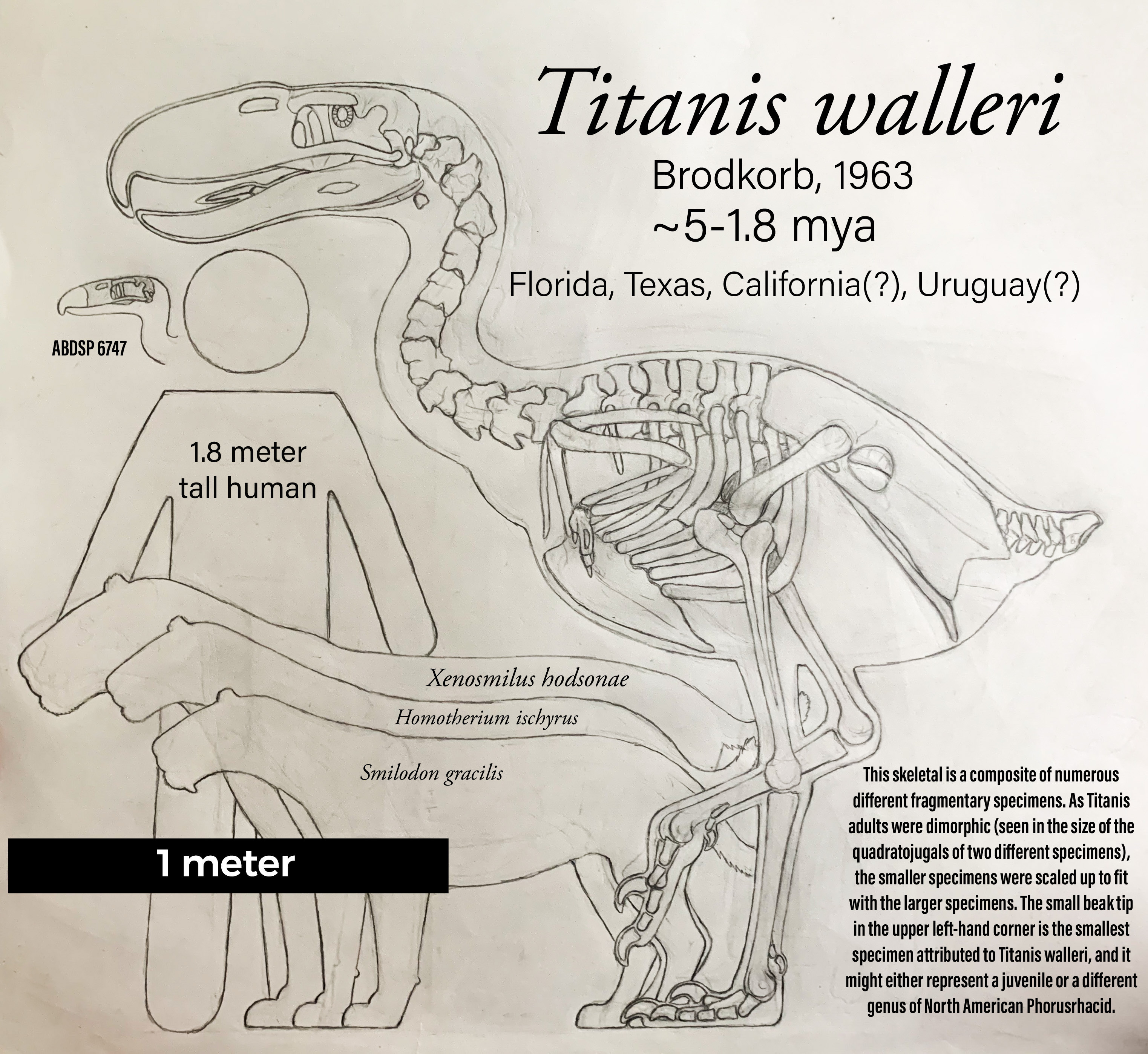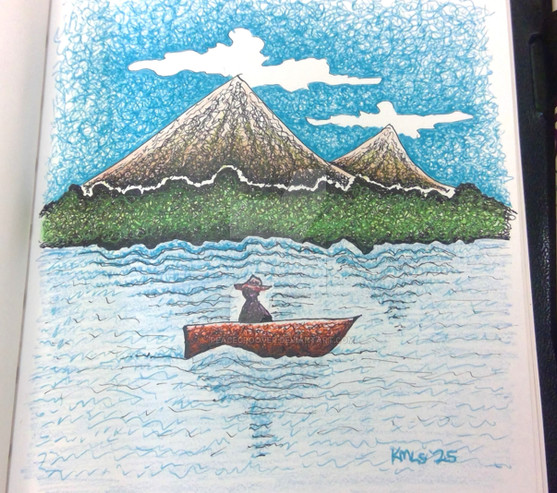HOME | DD
 RandomPaleonerd — The Terrorizer of North America, revised
RandomPaleonerd — The Terrorizer of North America, revised

#carnivore #cenozoic #sabertooth #titanis #terrorbird #phorusrhacid #apexpredator #bird #dinosaur
Published: 2020-06-18 18:16:39 +0000 UTC; Views: 8597; Favourites: 190; Downloads: 21
Redirect to original
Description
At long last, I’ve finished the revision of my previous Titanis skeletal! At about 2.15 meters tall and around the weight of a Siberian Tiger, Titanis walleri dwarfed many of the mammals that it shared its habitat with. This skeletal was based off of the Titanis (and potentially Titanis) specimens UF 137195, UF 162749, UF 137193, UF 137838, UF 57580, UF 57585, UF 144179, UF 30006, UF 30005, UF 30004, UF 10415, UF 10703, UF 144177, UF 137839, UF 10418, UF 30003, UF 12207, UF 144181, UF 144182, UF 9051, UF 7421, UF 144180, UF 7333, UF 30002, UF 137196, UF 12208, UF 4108 (type), UF 137194, UF 30007, UF 10416, UF 30001, UF 4109, UF 171382, UF 30010, UF 30011, UF 124228, UF 30009, UF 30008, UF 7332, UF 10417, MNHN 1563, ABDSP 6747, and TMM 43060-115. I used components from Andalgalornis, Llallawavis, Devincenzia, and Phorusrhacos to fill in missing elements.Titanis was the apex predator of its ecosystem, preying upon ground sloths, young Proboscideans, horses, and camelids. Its remains are often associated with woodlands and open forests, suggesting that Titanis niche partitioned with fellow apex predator Xenosmilus (while Xenosmilus would have preferred dense forests and wetlands, Titanis would have preferred open forests and woodlands).
Contrary to popular belief, Titanis was probably not driven extinct by mammalian carnivores. Xenosmilus went extinct at a similar point in time, with both Homotherium and Smilodon surviving to evolve into larger species. As both Homotherium and Smilodon were trophically lower at the time, my hypothesis is that Titanis and Xenosmilus both went extinct due to changes in their habitat. Titanis’s longleaf pine flatwood habitat relied very heavily on forest fire and Xenosmilus’s denser forest habitat relied heavily on rainfall, so changes in the local climate and conditions could damage such complex and fragile ecosystems. In contrast to this, grasslands are equipped to adapt to environmental change, which would have given Homotherium an advantage (as its habitat would have been able to adapt to environmental factors). Smilodon gracilis, which was a generalist in all three of the mentioned habitats, would have fared well simply due to the fact that it could exploit multiple types of prey and multiple types of habitat.
If you want to use this skeletal, please give credit!
References:
C. Tambussi, M. Ubilla & D. Perea (1999) The youngest large carnassial bird (Phorusrhacidae, Phorusrhacinae) from South America (Pliocene–Early Pleistocene of Uruguay), Journal of Vertebrate Paleontology, 19:2, 404-406, DOI: 10.1080/02724634.1999.10011154
Gould, G.C. & Quitmyer, Irvy. (2005). Titanis walleri: Bones of contention. Bulletin of the Florida Museum of Natural History. 45. 201-229.
Chandler, Robert & Jefferson, George & Lindsay, Lowell & Vescera, Susan. (2013). The Terror Bird, Titanis (Phorusrhacidae) from Pliocene Olla Formation, Anza-Borrego Desert State Park, Southern California Robert M.Chandler1, George T. Jefferson2 , Lowell Lindsay2, and Susan P. Vescera2 1 Biological and Environmental Science, Georgia College, Milledgeville, Georgia 31061 2 Department of Parks and Recreation, Colorado Desert District Stout Research Center, Borrego Springs, California 92004.
Jon A. Baskin (1995) The giant flightless bird Titanis walleri (Aves: Phorusrhacidae) from the Pleistocene coastal plain of south Texas, Journal of Vertebrate Paleontology, 15:4, 842-844, DOI: 10.1080/02724634.1995.10011266
Tambussi, Claudia & De Mendoza, Ricardo & Degrange, Federico & Picasso, Mariana. (2012). Flexibility along the Neck of the Neogene Terror Bird Andalgalornis steulleti (Aves Phorusrhacidae). PloS one. 7. e37701. 10.1371/journal.pone.0037701.
Degrange, Federico & Eddy, Drew & Puerta, Pablo & Clarke, Julia. (2019). New skull remains of Phorusrhacos longissimus (Aves, Cariamiformes) from the Miocene of Argentina: implications for the morphology of Phorusrhacidae. Journal of Paleontology. 10.1017/jpa.2019.53.
Alvarenga, Herculano M.F.; Höfling, Elizabeth (2003). "Systematic revision of the Phorusrhacidae (Aves: Ralliformes)". Papéis Avulsos de Zoologia. 43 (4): 55–91. doi:10.1590/S0031-10492003000400001.
Related content
Comments: 20

👍: 1 ⏩: 0

👍: 1 ⏩: 1

👍: 3 ⏩: 0

👍: 1 ⏩: 0

👍: 0 ⏩: 1

👍: 0 ⏩: 0

I’m personally curious? Are all the current Blancan/Irvingtonian scimitars under H. ischyrus rather than H. serum? I heard that paleontologists have started to regard all late Pleistocene remains of H. serum under H. latidens, which would mean that H. serum is potentially invalid. Granted I could be wrong here
👍: 0 ⏩: 0

I’m going to go fossil hunting along the Peace River in Florida next month and now I want a Titanis fossil for myself along with anything good. Can’t wait
👍: 1 ⏩: 1

👍: 2 ⏩: 0

👍: 2 ⏩: 0

👍: 0 ⏩: 0

👍: 2 ⏩: 1

👍: 2 ⏩: 0

👍: 1 ⏩: 0

👍: 0 ⏩: 1

👍: 2 ⏩: 1

👍: 0 ⏩: 0

👍: 2 ⏩: 0

👍: 1 ⏩: 0

👍: 2 ⏩: 0






















